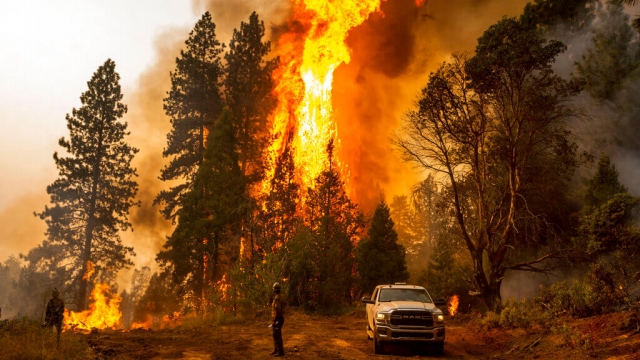When wildfire strikes, it can do so ferociously, quickly and seemingly out of nowhere.
"Fire is not new. Fire has been around for a long, long time," said Battalion Chief Paul Amundsen of the Colorado Division of Fire Prevention Control.
He says there are reasons as to why we're seeing wildfires on the scale that we have for the past 25 years.
Amundsen took Scripps News to see fire mitigation work in action at a public park in Evergreen, Colorado, which is about 30 minutes outside of Denver.
He believes measures like thinning trees and prescribed burns are helping to make up for decades of suppressing too much fire.
Along with a documented warming climate, he says our forests are more dense than they were a few generations ago.
"The fuels have just gotten to such a high level, such density, to where that's why we're seeing a lot of the fire behavior that we're seeing this day and age," he said.
SEE MORE: The US leads the world in weather catastrophes. Here's why
According to research by University of California, Berkeley and the Forest History Society, a historic combination of things led to our now denser forests. Those include outlawing indigenous forest maintenance burning in the 1800s and a deadly, destructive multi-million-acre wildfire in America's northwest in 1910. The fire, known as the big burn or big blow up, changed how the US Forest Service fought fires, and from 1910 until around the 1970s, the strategy was 100% suppression of every fire, no matter the cause or where the fire was burning.
"They wanted to put fires out to prevent something like that happening again, and that was a hundred percent the right thing to do at that point in time, because who could forecast out this could impact a hundred years from now?" said Amundsen.
This, combined with the warmer weather and stronger winds of the last couple decades, is why Amundsen says we have seen the biggest fires in recent history.
However, this kind of forest thinning of healthy trees, the kind that looks like logging, doesn't have everyone buying into this ideology. Some researchers and groups like the John Muir Project and the Eco-Integrity Alliance believe in preserving forests instead of thinning them for fire prevention. Both camps, however, agree on one thing to prevent fire destruction: home hardening.
Home hardening is the practice of building and maintaining homes with the goal of making them as firewise as possible—like building with less-flammable materials, cleaning gutters, getting rid of wood chips around the home, and thoughtful neighborhood planning.
SEE MORE: How museums are preparing for climate-related natural disasters
In this part of the country, memories of the 2021 Marshall Fire, a wildfire outside of Boulder, Colorado, that destroyed more than 1,000 homes and caused around $2 billion in damages, are fueling a conversation on the importance of hardening homes and preparing for the worst-case scenario.
"This is wonderful to see all this progress and gives people hope that there is a future after such a devastating event," said Garry Sanfaçon, the disaster recovery manager for Boulder County.
He has been helping the area get back on its feet since the fire. Currently, he says, about half of the people who lost their homes are rebuilding, like every home in this neighborhood.
"Rather than looking back and looking at history of weather and weather events as a predictor, you kind of have to look forward now, especially taking [into] consideration climate change,"Sanfaçon said.
Sanfaçon hopes other communities across the country take what happened in his county seriously, as it could happen anywhere. He hopes other communities will work to create emergency plans, make sure residents' insurance is adequate, and help people to reinforce their homes.
"This is the new normal, that we all are at risk and we need to plan accordingly, and a little bit of ounce of prevention can really help," Sanfaçon said.
Amundsen says that spring is a good time to put in the sweat equity of hardening one's home to defend it from fire.
While the history of the land can give us clues as to why wildfires are the way they are, prevention, mitigation, and hardening can rewrite the future of our families and community.
Trending stories at Scrippsnews.com




